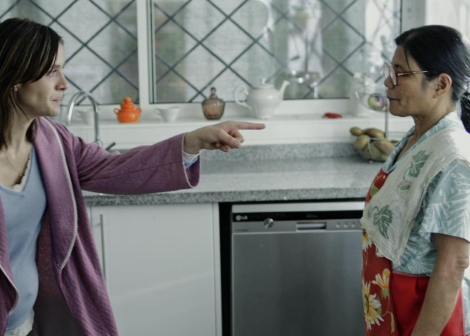
Directed and Written by: Aaron Burns
Starring: Daniela Ramírez, Matías Bassi, Cristobal Tapia Montt, Aida Jabolin, Nicolás Durán
Produced by: Nicolás López, Miguel Asensio Llamas
Music by: Manuel Riveiro
Cinematography by: Antonio Quercia
Editing by: Diego Macho Gómez
Official Selection of the 2017 SXSW Film Festival
*****
The eponymous parent in Aaron Burns’s new feature as writer/director, Madre, is a spoiled-shitless mother of one (with another on the way) living in the suburbs of Chile. Impatient, sensitive, and exhausted by her low-functioning autistic son Martin (Matías Bassi), Diana Prieto is unfit to be a homemaker – at least through the eyes of her husband, Tomás (Cristobal Tapia Montt), and to some extent, her own.

As Prieto, Daniela Ramírez lends the character a frantic, anguished presence, suggesting a woman whose near-spiritual idealization of family life has been ruined by an absent husband, a difficult son, and a complete lack of stimuli outside her home. We never see Diana partaking in a hobby, seeing a movie, or hiring a babysitter for Martin; by contrast, Tomás refuses to deal with his son, favoring his job as a consultant for continental Asian corporate entities (or, we suspect from Montt’s overly put-together Everyman look, from the sidepiece he is inevitably keeping from his wife.) Diana Prieto’s misery is devastatingly present, so much so that it becomes the basis for Burns’s paranoid body-horror, which divided audiences at its North American premiere last week at SXSW.
Madre kicks into high gear when a fed-up Diana is attacked by Martin, causing calamity in a supermarket until he is corralled by a kindly Filipino woman named Luz with One Hour Photo glasses and an unplucked mole (Aida Jabolin.) In a fit of coincidence, we learn that Luz also had an autistic child, but used a combination of specialty herbs, holistic caretaking, and, suspiciously, a kind of islander voodoo to “cure” her own boy. Prieto, desperate for a solution, hires Luz as Martin’s caretaker, in the hope that his misbehaviors can be foisted onto this poor stranger so Diana can, you know, dilly-dally for once (Ramírez is years too young for the role, with Bassi’s school-boy haircut failing to conceal that he is actually pubescent.)

For Burns, the Filipino stranger seems to present an “obvious” opportunity for scares, such that when he puts Luz and, eventually, her humble son David (Nicolás Durán, completely empty) in the Prieto household, the basic ethnic differences between the two families are supposed to tip us off to brewing intercultural terror.
From the moment the migrants enter the domestic Chilean space, Burns calls attention to the immense gaps in class, finance, taste, and worldliness between these people: the Prietos live in a spotless two-story home, shot entirely in high-key light by Antonio Quercia; and Elisa Hormazábal strikes savage comparisons between Diana and Tomás’s fine dresses and suits, and the comely clothes, trashy tattoos, and wife beaters that Luz and David wear to do house work. Where the Filipinos lived in Chile beforehand is anyone’s guess.
Their cultural contrasts are made to be visually obvious and the space between supposedly horrifying. We are told, beginning in the film’s second act, to fear the mysterious Filipino family because they speak to Martin in Tagalog, not Spanish, and may be “brainwashing” Diana’s son against his family in order to…well, what? The grotesque pay-off in Burns’s original script will please hard-core fans of his visual effects work for films like Eli Roth’s The Green Inferno and Machete (one wonders what role that film’s mastermind, Robert Rodriguez, played in securing this clumsy, cliché-riddled film’s position in SXSW’s illustrious Narrative Spotlight category), but it reveals a streak of unimaginative sadism in the sole credited screenwriter.

Not only does the film’s conclusion rely on explicit bigotry and class separatism – with Luz and David mowing lawns, packing lunches, and nursing Martin throughout Diana’s increasingly personal accusations against them – but it is also one of those endings where you think: “I know where this is going, but surely it can’t be right there in front of me.”
All this might have worked more easily in an artisanal context, or if Burns had meant Madre to work as a critique of the Prietos baseless yuppie racism. At first, the film does not exclude the possibility that Diana is imagining Luz’s devious machinations, with Jabolin’s performance striking just the right note between consoling and creepy (she reminded me of my own babysitter from childhood, “Aunt Val.”) But no attempt is made to beautify or stylize the mise-en-scène, with the filmmakers apparently more interested in getting to the big final shocker than in displaying aesthetic personality.
The one place where the crew work shines is in the production design of Marichi Palacios, whose team makes the Prieto household into a perfectly modern suburban hell-hole as richly decorated as the Amityville mansion, but with universal remotes and the like. Palacios also clutters the house with Martin’s props, and the high-tech kitchenware looks like it came out of a real-estate brochure, but nothing in our line-of-sight throughout this 95-minute feature looks like it belongs to Diana.
Even at that reasonable length and with the promise of fright, the film falters, due not only to its generalized look but also to its race-baiting plot and to its completely unconvincing central performances (having volunteered for Autism Speaks for years, I can politely describe Bassi’s hammy depiction of it here as crudely insensitive, even for a child actor.) I nonetheless am told that Madre has been acquired by Netflix for release, and that its writer/director has received major representation in the United States.
I therefore address this review to the distributor and talent agency directly: before willingly watching any more work by this team of filmmakers, I would personally need to hear a mea culpa.

